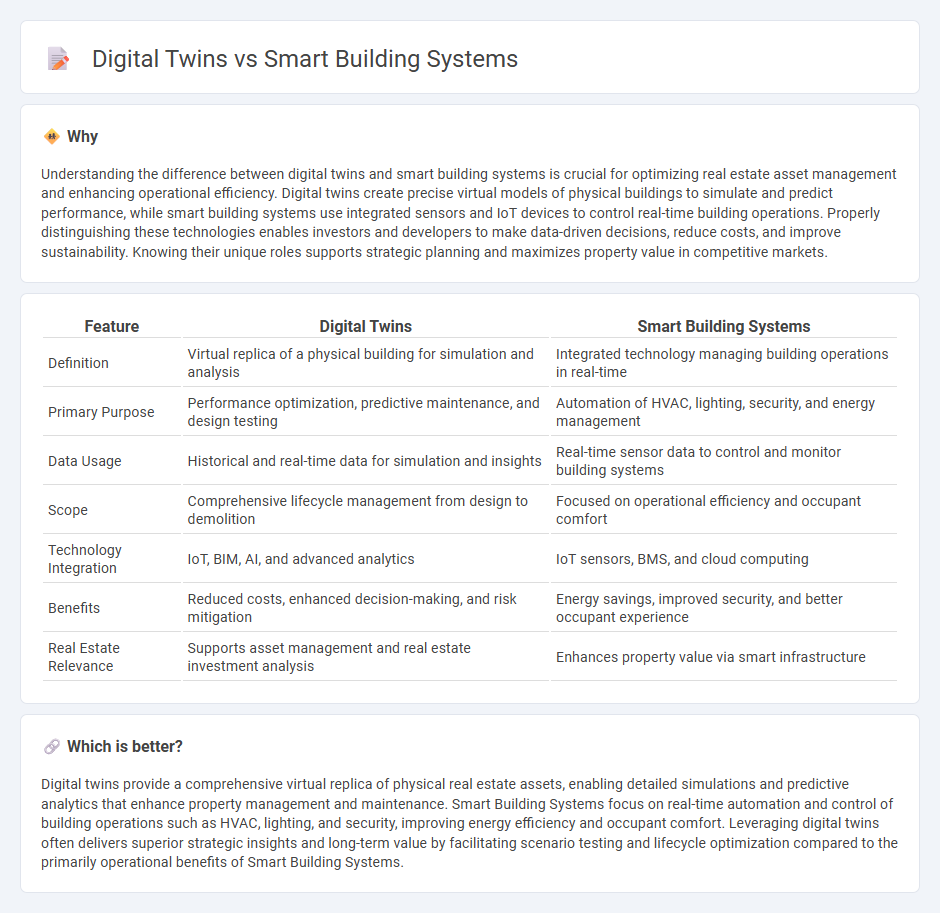
Digital twins create precise virtual replicas of physical properties, enabling real-time monitoring and predictive maintenance in real estate. Smart building systems integrate IoT devices to optimize energy use, enhance security, and improve occupant comfort. Explore how these technologies transform property management and investment strategies.
Why it is important
Understanding the difference between digital twins and smart building systems is crucial for optimizing real estate asset management and enhancing operational efficiency. Digital twins create precise virtual models of physical buildings to simulate and predict performance, while smart building systems use integrated sensors and IoT devices to control real-time building operations. Properly distinguishing these technologies enables investors and developers to make data-driven decisions, reduce costs, and improve sustainability. Knowing their unique roles supports strategic planning and maximizes property value in competitive markets.
Comparison Table
| Feature | Digital Twins | Smart Building Systems |
|---|---|---|
| Definition | Virtual replica of a physical building for simulation and analysis | Integrated technology managing building operations in real-time |
| Primary Purpose | Performance optimization, predictive maintenance, and design testing | Automation of HVAC, lighting, security, and energy management |
| Data Usage | Historical and real-time data for simulation and insights | Real-time sensor data to control and monitor building systems |
| Scope | Comprehensive lifecycle management from design to demolition | Focused on operational efficiency and occupant comfort |
| Technology Integration | IoT, BIM, AI, and advanced analytics | IoT sensors, BMS, and cloud computing |
| Benefits | Reduced costs, enhanced decision-making, and risk mitigation | Energy savings, improved security, and better occupant experience |
| Real Estate Relevance | Supports asset management and real estate investment analysis | Enhances property value via smart infrastructure |
Which is better?
Digital twins provide a comprehensive virtual replica of physical real estate assets, enabling detailed simulations and predictive analytics that enhance property management and maintenance. Smart Building Systems focus on real-time automation and control of building operations such as HVAC, lighting, and security, improving energy efficiency and occupant comfort. Leveraging digital twins often delivers superior strategic insights and long-term value by facilitating scenario testing and lifecycle optimization compared to the primarily operational benefits of Smart Building Systems.
Connection
Digital twins create virtual replicas of physical real estate assets, enabling detailed monitoring and simulation of building performance in real time. Smart Building Systems utilize these digital models to optimize energy consumption, enhance security, and improve occupant comfort through automated controls and data analytics. This integration drives predictive maintenance and efficient space management, transforming property management and operational strategies.
Key Terms
IoT Integration
Smart Building Systems leverage IoT integration to optimize energy consumption, enhance security, and improve occupant comfort through real-time data analytics and automated controls. Digital twins extend these capabilities by creating virtual replicas of physical buildings, enabling advanced simulations, predictive maintenance, and performance optimization based on IoT sensor data. Explore the transformative potential of IoT in Smart Building Systems and digital twins to drive innovation and operational efficiency.
Real-time Data Visualization
Smart building systems leverage real-time data visualization to optimize energy efficiency, occupant comfort, and operational performance by integrating sensors and IoT devices throughout the infrastructure. Digital twins enhance this approach by creating dynamic virtual replicas of buildings, enabling predictive analytics and scenario simulations based on continuous data streams. Explore how these technologies compare in transforming facility management and decision-making processes.
Predictive Maintenance
Smart building systems integrate IoT sensors and AI algorithms to continuously monitor equipment health and detect anomalies for predictive maintenance, reducing downtime and operational costs. Digital twins create virtual replicas of building assets, enabling simulation and precise forecasting of system failures by analyzing real-time and historical data. Explore how combining smart building systems with digital twins can revolutionize predictive maintenance strategies.
Source and External Links
Smart Building Technology Solutions & Examples - This article discusses how smart buildings use automated processes and sensors to control operations like heating, ventilation, and security, enhancing efficiency and safety.
Smart Buildings | Technology Trends and Innovations - This resource highlights smart buildings' use of IoT devices and AI to optimize performance, improve comfort, and reduce environmental impact through features like predictive maintenance.
What Is a Smart Building? - This page explains how smart buildings integrate various systems like HVAC, lighting, and security into a single network to enhance efficiency and operations.
 dowidth.com
dowidth.com